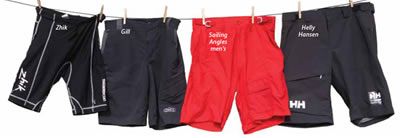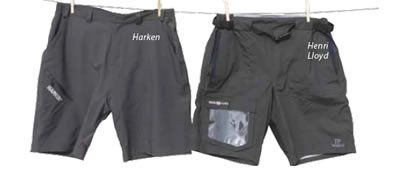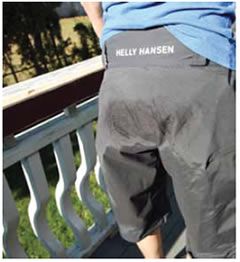
Photos by David Liscio
381

397
No matter whether aboard a racing dinghy or an ocean-romping supermaxi, repeatedly scooching across a nonskid deck or sitting for long periods on the rail will take its toll on your backside and thighs. Padded, quick-dry sailing shorts can significantly reduce the discomfort. Practical Sailor recently tested eight pairs of sailing shorts from top sailing apparel makers to find out which ones offer the most protection and comfort for idle or scooching, wet sailor butts.
What Sailing Shorts We Tested
The test field comprised sailing shorts from Helly Hansen, Harken, Gill, Sailing Angles, Henri Lloyd, Zhik, and Camet International. We included two models of women’s padded shorts, one from Sailing Angles and another from Camet. The Camet men’s shorts did not arrive in time to be tested for this report, but look for a follow-up review of them in a future issue.
The shorts ranged in price from $75 to $164 and came in a variety of fast-dry, “technical“ fabrics; most are available in multiple colors or patterns. All of the shorts offer UV protection.
With the exception of the Helly Hansen and Zhik shorts, all of those tested can accommodate closed-cell foam padding. The Zhik shorts are permanently padded, and the Helly shorts have no pad pockets.
How We Tested the Sailing Shorts
Practical Sailor put the test shorts through a series of bench tests emulating a few seasons of active wear onboard a sailboat. The tests were designed to evaluate ruggedness and durability, comfort, ease of use (inserting foam pads), drying time, odor resistance, color retention, and any tendency for the fabric to shrink. Each pair also was evaluated on its features, including pockets, zippers, Velcro closures, fasteners, stitching, and the quality of material and construction.
To determine resistance to abrasion, testers donned each pair of shorts and while standing, swayed their hips back and forth 50 times across 120-grit sandpaper affixed to a 2-x-4 length of lumber. This was designed to simulate accelerated wear, the sort of abuse shorts get when rubbed against gunwales, aggressive nonskid, and other rough deck surfaces over time.
With the pads removed (except the Zhik), the shorts also were immersed in both fresh and salt water and then allowed to air dry; testers noted and compared their dry times and rated them accordingly. To gauge odor resistance, testers placed soaking wet shorts into individual, sealed black plastic bags for 72 hours, then removed them and conducted sniff tests for mildew odor.
Zippers, Velcro strips, and button closures were operated 25 times each to learn whether heavy use might impair functionality. We also ran each pair of shorts through a washing machine a few times to see whether the material would shrink or fade. All of the test shorts maintained their original color, and none shrank during laundering.
Gill
The Gill men’s black padded performance sailing shorts vied closely with the Helly Hansen shorts for the most fashionable style. The Gill shorts—designed in the UK but made in China—are made of a lightweight, soft Nylon Tactel fabric with a water-repellent finish; they were the second fastest drying in the open-air test.
The shorts feature belt loops, elastic comfort stretch bands on both sides of the waist, a sturdy zipper, and a button closure. They have two open slash pockets and a third front cargo pocket on the left thigh; the latter with a Velcro closure and weather flap.
The shorts have no interior lining or mesh, but the seat has a reinforced panel, and two separate interior pockets with Velcro closures accommodate the seat pads. According to Gill, internal pad pockets are better for hiking out and make the shorts more versatile for wear off the boat (without pads). The pads are imprinted with dotted cutting lines to help guide trimming for a customized fit.
During the abrasion test, the Gill shorts chafed an acceptable amount, mostly in places where the material was thin near the quadruple-stitched rear seam.
Bottom line: Lightweight comfort, easily customized pads, and a competitive $89 price earn the Gill shorts the PS Best Choice.
Harken
We tested the Harken men’s black Ballistic Eco sailing shorts with pads. They are made of 68-percent ballistic nylon, 18-percent patented bamboo charcoal, and 14-percent Spandex. According to Harken, bamboo charcoal is natural bamboo heated to 1472 degrees (800 degrees C), then blended with nanoparticles before being embedded into the yarn for weaving. It makes the shorts anti-microbial by allowing the material to disperse both moisture and heat naturally. Testers noted that the material was more supple and stretchy than that of the other shorts tested. Even when worn for hours, the shorts remained comfortable.
The Ballistic Eco shorts feature belt loops, a smooth-operating zipper, and a button front closure. They also have two open slash pockets and two rear cargo pockets with Velcro closures. A shallow front pocket on the right leg is zippered and ideal for securing small items like chapstick.
The entire backside of the shorts opens up with a long Velcro band to allow easy insertion of the pads, which can be trimmed for a custom fit. During the abrasion test, the rear chafed an acceptable amount, and the double-stitched rear seam held up well. The shorts survived the odor resistance test, but they were slow to dry in the open air and remained damp after 1½ hours.
Made in China, the shorts are machine washable and retail for $106.
Bottom line: Features, materials quality, and comfort make these shorts a PS Recommended product.

240
Helly Hansen
The Helly Hansen Hydro Power technical shorts that we tested were black with belt loops and twin Velcro adjustments on either side of the waist. Testers noted that they were the most fashionable of the men’s test field.
The Velcro tabs, measuring 1-by-3 inches, do a good job of snugging the waist. Two metal snap buttons and a metal clip hold the waist closed. Although these performed without a hitch during tests, the design raises minor concern because metal fasteners tend to wither in the marine environment, and unlike a button that can easily be sewn back on, the closure would be difficult to repair. The zipper, which operated smoothly in tests, is strong and sturdy with a tab that is big enough to grab even with gloved fingers.
Made in China, the Helly shorts offer quality construction with a polyamide shell, double-stitched front and back panels, and polyester lining. The right leg has a deep, square, zippered, external pocket with a weather flap to keep out spray. Unlike the other test shorts, the Helly Hydro Power features interior mesh netting, which serves as a chafe guard. Such features can make a big difference in comfort and highlight why shorts designed for sailing far outshine the option of donning underwear and walking shorts—a combination better suited for dock walking than rail riding.
Testers noted that the material fuzzed and abraded more readily than some other test products. According to Helly Hansen, “While the Hydro Power short may have abraded in this accelerated wear test, Helly Hansen has never seen excessive wear in these shorts when used in real-world conditions.’’ The company has had no customer complaints about durability or excessive wear. When it comes to fabric, the company explained, “The burlier a garment, the less comfortable and stylish it will be. Helly Hansen’s job is to find the right balance to ensure its customers have the most purposeful gear.’’
In our opinion—and for the purposes of this test—the shorts’ biggest shortcoming was the inability to add padded inserts. These $100 shorts may be better suited for non-hiking racing, swimming, or other water-related activities.
Bottom line: Testers liked the look and comfort of the Hydro Power shorts—and would recommend them as swimwear or shorts for other activities—but their lack of pad pockets keep them out of contention in this test field.
Henri Lloyd
We tested the men’s black Henri Lloyd Shockwave Shorts with a patented Deck Armour seat and knees. The well-made shorts have two zippered slash pockets and a front cargo pocket on the right thigh that is fitted with a Velcro closure and storm flap. The pocket also has a clear plastic window, where a small GPS could be stored and still be visible.
The shorts have an adjustable nylon-webbing belt and plastic snap buckle. The waist is sewn closed at the front but has a coated zipper to accommodate trips to the head. The double-stitched shorts are reinforced with rugged 500D Cordura material at the seat.
The breathable and very flexible pads are inserted into two rear pockets from the inside of the shorts. They feature a mesh design that allows movement and air to pass through, but the non-absorbent pads cannot be trimmed. The silicone-based pads are constructed of Deflexion, a high-performance, shock-absorbing material developed by Dow Corning.
During the abrasion test, the Cordura material quickly became fuzzy, but it did not wear through. The Shockwave shorts were the fastest drying men’s shorts, but the see-through plastic on the pocket fogged up and kept the pocket from drying completely or quickly. Although the pocket seems like a handy feature, the shorts would not be degraded by its elimination, in our opinion.
Made in Poland, the Henri Lloyd shorts retail for $125, plus $39 for the set of pads.
Bottom line: Testers liked the Shockwave pads, design, and features, and recommend the shorts for those who don’t flinch at spending $160-plus on racing shorts.
Sailing Angles
Lightweight and soft, Sailing Angles’ Bermuda Breaker shorts are made of a quick-drying, cotton-like Supplex fabric that is double-stitched at the seams. The shorts feature a front zipper, two buttons for closure, deep front pockets, and belt loops all around, as well as twin plastic D-rings fitted with a strip of material and Velcro tabs for waist adjustment. The tabs are small, about three-quarters of an inch square, and those on the test shorts had a hard time holding the waist-adjusters in place.
Made in Costa Rica, the shorts’ seat is reinforced with Cordura, and a single external pocket with Velcro closure accommodates the 3/8-inch-thick, flexible closed-cell foam seat pad, which Sailing Angles calls the Fanny Fender. The pad can be custom trimmed and is less dense than other pads in the test.
The men’s Bermuda Breakers showed some wear after abrasion testing, but their seams held up well. After 72 hours in the black plastic bag, the Sailing Angles shorts had a slight mildew odor and remained wet. However, they dried quite quickly in the open air.
The shorts retail for $65, plus $10 for the customizable pads.
Bottom line: An average performer with a low price, the men’s Bermuda Breakers did not top the best picks.
Zhik
The Zhik Deckbeaters look like a cross between biking shorts and a wetsuit. Certainly the anomaly of the lot, the black men’s shorts we tested proved both durable and comfortable.
Like padded biking shorts, the Deckbeaters’ padding is permanently built into the shorts. The shorts, secured with a drawstring, offer a snug fit and seem to run on the small side. They are made from 82-percent nylon and 18-percent Spandex; machine washing is discouraged. Although sleek and tight-fitting, the Zhik shorts are comfortable and can be worn on their own or layered under loose pants or shorts. Testers found them to be breathable enough, but we did not test them for prolonged periods in hot weather. The design seems well-suited for dinghy racers.
During the abrasion test, the seat suffered some chaffing but showed no significant wear and the heavy-duty, zigzagged seams fared well. The shorts dried relatively quickly in the open air and had no mildew odor after a few days in a black plastic bag.
Made in China, the Zhik shorts retail for $109.
Bottom line: Well-made shorts—as the price implies—the Deckbeaters are recommended for dinghy racers.

Women’s Sailing Shorts
Women’s sailing shorts are relatively scarce in the marketplace. Most manufacturers apparently think women sailors should simply don a pair of men’s shorts, but as you can imagine, that would be neither comfortable nor attractive. We tested two women-specific padded sailing shorts for this evaluation and are on the lookout for others to test.
Sailing Angles
The Sailing Angles women’s Bermuda Breaker shorts are identical to the men’s shorts in all respects—fabric, features, etc.—except style. The women’s shorts have a 10-inch inseam and are high-waisted with a pleated front and wide legs. When the Fanny Fender foam pads are inserted, the effect looks like a huge butterfly trapped inside the rear panel of the shorts. The pads can be trimmed to fit (and to minimize this effect); and the shorts’ wide legs do offer the wearer unencumbered maneuverability. According to Sailing Angles, all new women’s shorts will be flat fronted.
Although we only tested shorts this go-round, testers noted that Sailing Angles does offer a line of women’s capri pants that have optional butt padding, and the capris are more fashion-forward and stylish than the women’s Bermuda Breakers. We hope to test out the capris soon; stay tuned.
The shorts dried quickly but had a slight mildew odor after testing. During abrasion testing, the women’s Bermuda Breakers showed a fair amount of wear and suffered a tear at the double-stitched rear seam of the pad pocket. While seam blowouts are easy to repair with a home sewing machine or needle and thread, the failure would be covered under Sailing Angles warranty. According to Sailing Angles, in more than five years, the company has only had six shorts returned or repaired for such a failure. “My customers obviously don’t use their shorts in a way that reflects how you and your test and testers use them,“ Sailing Angles’ Donald Elliott explained to PS. “Otherwise, I would get a lot more returns, calls, and/or comments.“
Like the men’s version, these retail for $65 plus $10 for the padded insert.
Bottom line: Pricing is attractive, but for $10 more, we’d opt for the Camet shorts.
Camet
The women’s Camet Wahine shorts are lightweight and designed with a woman’s figure in mind. The shorts are low rise with an 8-inch inseam, and they have a flat front with pockets that lay flat. The fabric is lightweight nylon with a durable water-repellent finish that dries quickly and offers UV protection. Made in the USA, the shorts feature belt loops, a somewhat small dipper pocket, and a button closure.
The seat is reinforced with Cordura, which passed the abrasion test without significant wear. The seat pad is inserted into a pouch sewn on the outside of the seat. Slightly stiff, the pads lend an ungainly overall look that can be tamed by trimming the pads to fit; however, most women sailors will want to remove the pads before heading to the clubhouse after sailing.
The Camet shorts dried rapidly in the open air: They were only slightly damp after a mere 15 minutes and totally dry after a half-hour. After 72 hours in a sealed bag, the shorts had no odor. The shorts retail for $75 with pads.
Bottom line: The Wahine is the PS Best Choice for women’s padded shorts in this test field.
Conclusion
The Gill, Harken, and Henri Lloyd shorts were standouts in overall performance and comfort. The Harken shorts were the most comfortable when worn for several hours at a stretch. Both the Henri Lloyd and the Gill shorts were rugged, fast-drying, and offered desirable features. Henri Lloyd’s padding system is also in a class by itself, superior for its breathability and protection.
While the Helly Hansen shorts were commendable for style and construction, they didn’t make the grade due to the inability to insert padding. The Zhik shorts, certainly a product deserving of recognition, remains an anomaly given the snug bicycle-shorts styling and integrated, non-adjustable padding; however, these remain a good option for dinghy sailors.
The Camet Wahines were the top pick for women as they were tailored specifically for female bodies and they held up well during bench and field tests.









































super helpful. Thanks so much. pity there are so few options for women. I have the Camet and they are not flattering and a bit too short for dinghy sailing.
I too would like more options for women! I’m willing to bet our seatbones are more tender AND our natural padding is nowhere near as efficient as a man’s. HELP!!
Now I’m a bit upset. I went to the Camet website, wrote an email requesting more info as your recommended shorts were not there. After not hearing anything I called. I got what sounded like a personal phone from someone supposedly in California but not sounding like he was from there. I said, “Hmmm this doesn’t sound like it’s a real organization.” He answered – thankfully being honest – “No, no, we’re just playing around.”
??????????!!!!!!!!!!!!!!!!
I truly hope someone is seeing this?! I was relying on your evals to find a decent pair of sailing shorts! Not good!